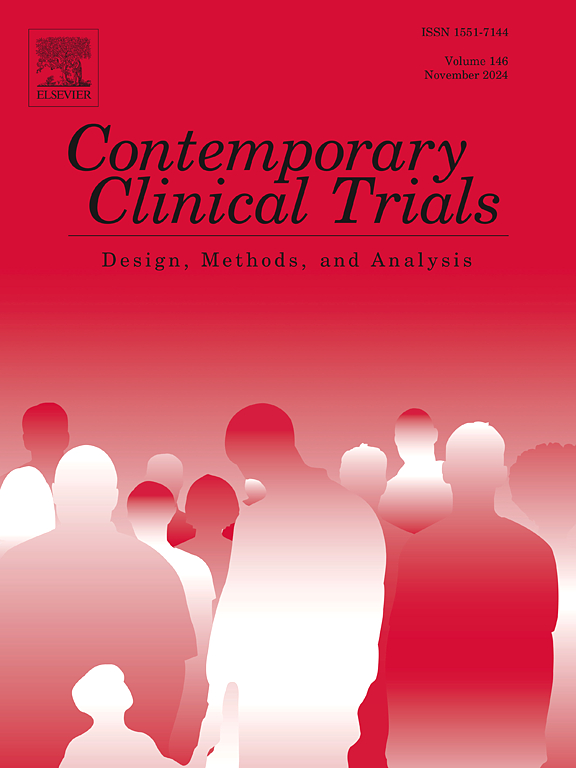Design and methods of a cluster-randomized pragmatic trial of post-discharge stroke care
IF 2
3区 医学
Q3 MEDICINE, RESEARCH & EXPERIMENTAL
引用次数: 0
Abstract
Background
Stroke is the 5th leading cause of death and a leading cause of adult disability in the United States (US). One in four strokes are recurrent events. Stroke patients experience persisting physical and cognitive impairments long-term, and their caregivers/family also experience psychological and health quality impacts. The current standard for stroke care in the US utilizes hospital certifications based on level of available care and includes proven acute and in-hospital care processes and offers limited post-discharge care coordination of risk factor management, secondary prevention, and early and continued rehabilitation that have been shown beneficial for recovery. The Joint Commission (TJC) Comprehensive Stroke Care (CSC) certification is awarded to hospitals that provide the most advanced level of stroke care. Another model of care in use in the US is a patient-centered, technology-enabled Integrated Stroke Practice Unit (ISPU) that incorporates team-based care components across the continuum. While risk factor management and early rehabilitation occur during hospitalization, these become the focus and are facilitated in the ISPU post-discharge. While both models have shown effectiveness, understanding which model yields better outcomes is critical scientific information for the stroke community.
Methods
This paper reports the protocol for the Coordinated, Collaborative, Comprehensive, Family-Based, Integrated, and Technology-Enabled Stroke Care (C3FIT), including rationale, design, and methodology for the study. C3FIT is a pragmatic, multicenter, single masked, Phase III, cluster randomized clinical trial designed to determine effectiveness of two US stroke care models - TJC CSC care (CSC-Only; active control) compared to a model that layers the ISPU model on top of CSC care (ISPU+CSC; intervention). Up to 23 clinical sites were stratified by geographic region and patient admission volume and randomized at the site level. Participants included patients (or their Legally Authorized Representative) and their caregiver (if available). Participants in each treatment group were followed through in-person, virtual, or phone contact at 3-, 6-, and 12-months post-discharge; participants in the ISPU+CSC arm were also seen at 1-, 2-, 4-, 5-, 7-, 8-, 9-, 10- and 11-months post-discharge. Patient-centered primary outcomes were patient function and quality of life (measured using the simplified modified Rankin Scale and Stroke Impact Scale respectively) at 12-months post-stroke. Treatment differences were assessed using generalized linear mixed models incorporating assessments at 0, 3, 6 and 12 months, with the primary treatment differences evaluated by a contrast statement assessing the 12-month difference.
Conclusion
Results from C3FIT will help to determine which model of care yields better outcomes for patients and their caregivers, which will build scientific evidence about post-stroke recovery and has the potential to impact post-stroke care across the country.
Trial registration
This trial is registered at ClinicalTrials.gov (NCT04000971).
卒中出院后护理的群随机实用试验的设计和方法。
背景:中风是美国第五大死亡原因和成人残疾的主要原因。四分之一的中风是复发性的。脑卒中患者会经历长期持续的身体和认知障碍,他们的照顾者/家人也会经历心理和健康质量的影响。美国目前的中风护理标准采用基于现有护理水平的医院认证,包括已证实的急性和住院护理过程,但提供有限的出院后护理协调风险因素管理、二级预防和早期和持续的康复,这些已被证明有利于康复;联合委员会(JC)全面中风护理(CSC)认证授予提供最先进中风护理水平的医院。在美国使用的另一种护理模式是以患者为中心的、技术支持的综合卒中实践单元(ISPU),它在整个连续体中结合了基于团队的护理组件。虽然风险因素管理和早期康复发生在住院期间,但这些成为重点,并在ISPU臂出院后得到促进。虽然两种模型都显示出有效性,但了解哪种模型产生更好的结果对中风社区来说是至关重要的科学信息。方法:本文报道了协调、协作、综合、以家庭为基础、综合和技术支持的脑卒中护理(C3FIT)方案,包括研究的基本原理、设计和方法。C3FIT是一项实用的、多中心、单盲、III期、集群随机临床试验,旨在确定两种美国卒中治疗模式的有效性:JC CSC carerecc - only;控制)与ISPU模型在CSC护理(ISPU+CSC;干预)。多达23个临床站点按地理区域和患者入院量分层,并在站点水平上随机化。参与者包括患者(或其法定授权代表)及其护理人员(如果有的话)。每个治疗组的参与者在出院后3个月、6个月和12个月通过面对面、虚拟或电话联系进行随访;ISPU+CSC组的参与者在出院后1、2、4、5、7、8、9、10和11个月也被观察到。以患者为中心的主要结局是卒中后12个月的患者功能和生活质量(分别使用简化的修正Rankin量表和卒中影响量表测量)。使用广义线性混合模型评估治疗差异,包括0、3、6和12 个月的评估,主要治疗差异通过对比声明评估12个月的差异来评估。结论:C3FIT的结果将有助于确定哪种护理模式对患者及其护理人员产生更好的结果,这将为卒中后康复建立科学证据,并有可能影响全国的卒中后护理。试验注册:该试验在ClinicalTrials.gov注册(NCT04000971)。
本文章由计算机程序翻译,如有差异,请以英文原文为准。
求助全文
约1分钟内获得全文
求助全文
来源期刊
CiteScore
3.70
自引率
4.50%
发文量
281
审稿时长
44 days
期刊介绍:
Contemporary Clinical Trials is an international peer reviewed journal that publishes manuscripts pertaining to all aspects of clinical trials, including, but not limited to, design, conduct, analysis, regulation and ethics. Manuscripts submitted should appeal to a readership drawn from disciplines including medicine, biostatistics, epidemiology, computer science, management science, behavioural science, pharmaceutical science, and bioethics. Full-length papers and short communications not exceeding 1,500 words, as well as systemic reviews of clinical trials and methodologies will be published. Perspectives/commentaries on current issues and the impact of clinical trials on the practice of medicine and health policy are also welcome.

 求助内容:
求助内容: 应助结果提醒方式:
应助结果提醒方式:


